courtesy Texas Instruments
![]()
![]() DALLAS
(January 7, 1993) -- "Calculators from Texas who?" That question was
often asked during the first days of the electronic calculator industry, but
as the market grew, Texas Instruments became an industry leader and a household
name in homes -- as well as in schools, offices and factories -- around the
world.
DALLAS
(January 7, 1993) -- "Calculators from Texas who?" That question was
often asked during the first days of the electronic calculator industry, but
as the market grew, Texas Instruments became an industry leader and a household
name in homes -- as well as in schools, offices and factories -- around the
world.
TI was already an industrial giant when it entered the consumer products business in 1972. Founded in 1930 as Geophysical Service, the company began by providing contract exploration services to the petroleum industry and evolved into a leading designer and manufacturer of innovative defense electronics systems and semiconductors. TI was the first to mass produce silicon transistors in 1954 and invented the integrated circuit -- the micro-chip -- in 1958 and the electronic hand-held calculator in 1967. Shipments of calculators bearing the TI brand began five years later.
Here's a snapshot of some of TI's most memorable consumer products, beginning with the announcement of its first commercial calculator 20 years ago.
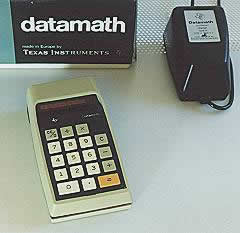
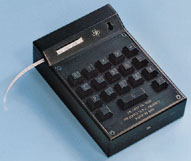
![]() 1972
TI-2500* DataMath[tm]calculator. TI's first consumer product, this electronic
hand-held calculator made everyday math quick and easy. The TI-2500 performed
four arithmetic functions (addition, subtraction, multiplication and division)
and had a red, eight-digit light-emitting diode (LED) display; it used an adapter
to recharge the batteries. Announced in April 1972 with a suggested retail price
(SRP) of $149.95, the price was reduced to $119.95 when the product was formally
introduced on September 21, 1972.
1972
TI-2500* DataMath[tm]calculator. TI's first consumer product, this electronic
hand-held calculator made everyday math quick and easy. The TI-2500 performed
four arithmetic functions (addition, subtraction, multiplication and division)
and had a red, eight-digit light-emitting diode (LED) display; it used an adapter
to recharge the batteries. Announced in April 1972 with a suggested retail price
(SRP) of $149.95, the price was reduced to $119.95 when the product was formally
introduced on September 21, 1972.
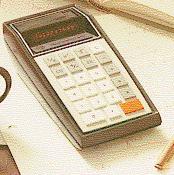
![]() 1973
SR-10* began shipping in high volume. With an SRP of $149.95, this portable
slide-rule calculator with scientific notation was the first with a price comparable
to that of basic hand-held calculators. It performed reciprocals, squares and
square roots more quickly and more accurately than classical slide rules and
handled four arithmetic functions, as well.
1973
SR-10* began shipping in high volume. With an SRP of $149.95, this portable
slide-rule calculator with scientific notation was the first with a price comparable
to that of basic hand-held calculators. It performed reciprocals, squares and
square roots more quickly and more accurately than classical slide rules and
handled four arithmetic functions, as well.

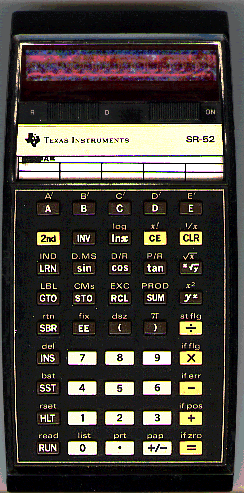
![]() 1974
SR-50*. This advanced slide-rule calculator with memory performed all the classical
slide-rule functions including the SR-10's functions, universal powers and roots,
factorials, trigonometric and hyperbolic functions and their inverses, common
and natural logarithms and e(x). Scientific notation. It also featured a 14-character
LED display and pi key. Direct-marketed initially at $169.95; later sold through
dealers.
1974
SR-50*. This advanced slide-rule calculator with memory performed all the classical
slide-rule functions including the SR-10's functions, universal powers and roots,
factorials, trigonometric and hyperbolic functions and their inverses, common
and natural logarithms and e(x). Scientific notation. It also featured a 14-character
LED display and pi key. Direct-marketed initially at $169.95; later sold through
dealers.
![]() 1975
SR-52* programmable calculator with nonvolatile magnetic card storage. More
programming and memory power than comparable models offered at twice the price,
the SR-52 stored up to 224 program steps and values on 2-7/8 by 5/8-inch magnetic
cards. Twenty user memories; 23 preprogrammed functions and operations; programming
capabilities included 82 user-defined keys and labels, branching, flags and
subroutines. AOS[tm] Algebraic Operating System with nine levels of parentheses.
Basic library software with 22 program cards included; optional software libaries,
thermal printer/plotter and PPX-52 Professional Program Exchange available.
Introduced at a $395.00 SRP.
1975
SR-52* programmable calculator with nonvolatile magnetic card storage. More
programming and memory power than comparable models offered at twice the price,
the SR-52 stored up to 224 program steps and values on 2-7/8 by 5/8-inch magnetic
cards. Twenty user memories; 23 preprogrammed functions and operations; programming
capabilities included 82 user-defined keys and labels, branching, flags and
subroutines. AOS[tm] Algebraic Operating System with nine levels of parentheses.
Basic library software with 22 program cards included; optional software libaries,
thermal printer/plotter and PPX-52 Professional Program Exchange available.
Introduced at a $395.00 SRP.
![]() 1976
TI-5040. TI's first desktop calculator with a large, bright vacuum fluorescent
(VF) display and a clean, quiet, convenient thermal printer. Crisp styling and
many useful features including four-function memory; independent add mode; floating
or add-mode decimal; 10-digit display with comma and decimal point punctuation.
Operated from household current. SRP $149.95.
1976
TI-5040. TI's first desktop calculator with a large, bright vacuum fluorescent
(VF) display and a clean, quiet, convenient thermal printer. Crisp styling and
many useful features including four-function memory; independent add mode; floating
or add-mode decimal; 10-digit display with comma and decimal point punctuation.
Operated from household current. SRP $149.95.
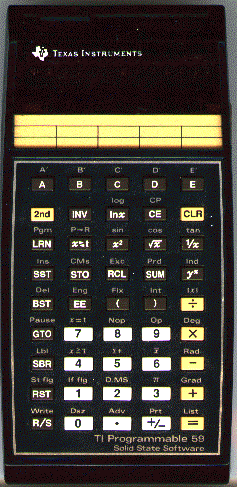
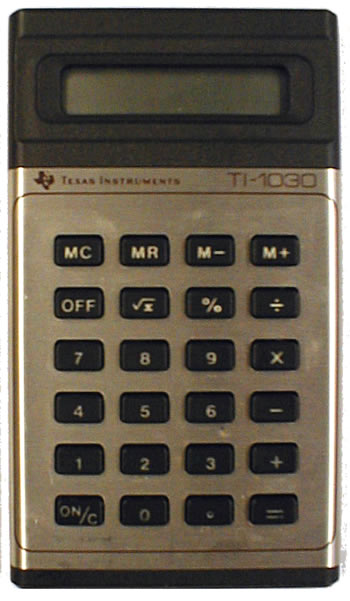
![]() 1977
TI Programmable 59*. This advanced programmable calculator offered users 960
program steps or up to 100 memories, and it was the first TI calculator to offer
both magnetic card storage and interchangeable, plug-in Solid State Software[tm]
modules with up to 5,000 program steps. More than 175 functions and operations.
Master library with 25 programs included; optional software libaries, thermal
printer/plotter and Professional Program Exchange available. SRP $299.95.
1977
TI Programmable 59*. This advanced programmable calculator offered users 960
program steps or up to 100 memories, and it was the first TI calculator to offer
both magnetic card storage and interchangeable, plug-in Solid State Software[tm]
modules with up to 5,000 program steps. More than 175 functions and operations.
Master library with 25 programs included; optional software libaries, thermal
printer/plotter and Professional Program Exchange available. SRP $299.95.
![]() 1978
TI-1030. The first calculator TI manufactured with a low-power CMOS chip and
a liquid crystal display (LCD). Thin as a pencil and supplied in a handy wallet
folder, the Slimline TI-1030 operated for up to 3,000 hours on a pair of silver-oxide
batteries. Performed four functions, percentages and square roots; weighed less
than 2.5 ounces. Four-key memory with large eight-digit display.
1978
TI-1030. The first calculator TI manufactured with a low-power CMOS chip and
a liquid crystal display (LCD). Thin as a pencil and supplied in a handy wallet
folder, the Slimline TI-1030 operated for up to 3,000 hours on a pair of silver-oxide
batteries. Performed four functions, percentages and square roots; weighed less
than 2.5 ounces. Four-key memory with large eight-digit display.
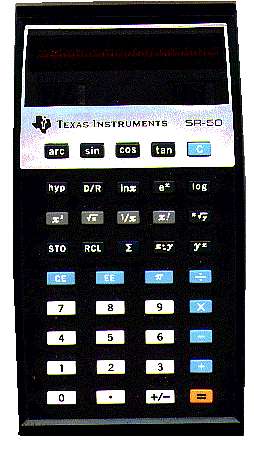
![]() 1978
TI-50. The first scientific calculator TI manufactured with a low-power CMOS
chip and an LCD. Handsome and compact, the Slimline TI-50 slide rule performed
60 math and statistics functions useful to college students and professionals.
Two versatile Constant Memory[tm] registers retained data even when the calculator
was turned off. Operated for up to two years on a set of batteries; weighed
just three ounces. SRP $35.00.
1978
TI-50. The first scientific calculator TI manufactured with a low-power CMOS
chip and an LCD. Handsome and compact, the Slimline TI-50 slide rule performed
60 math and statistics functions useful to college students and professionals.
Two versatile Constant Memory[tm] registers retained data even when the calculator
was turned off. Operated for up to two years on a set of batteries; weighed
just three ounces. SRP $35.00.
![]() 1979
TI-35. Another popular model in TI's scientific calculator family, the Slimline
TI-35 slide rule for students packed with 54 easy-to-use math and scientific
functions. Versatile memory with Constant Memory feature. Pencil-thin with a
large LCD; long battery life. $33.00 SRP.
1979
TI-35. Another popular model in TI's scientific calculator family, the Slimline
TI-35 slide rule for students packed with 54 easy-to-use math and scientific
functions. Versatile memory with Constant Memory feature. Pencil-thin with a
large LCD; long battery life. $33.00 SRP.
![]() 1981
TI-1766. TI's first solar-powered, four-function hand-held calculator. Handled
percentages and square roots. Sleek and convenient, the TI-1766 had solar cells
that eliminated the need for batteries and powered the calculator indoors and
out. Eight-digit LCD; four-key memory. Weighed under 2.0 ounces. $19.95 SRP.
1981
TI-1766. TI's first solar-powered, four-function hand-held calculator. Handled
percentages and square roots. Sleek and convenient, the TI-1766 had solar cells
that eliminated the need for batteries and powered the calculator indoors and
out. Eight-digit LCD; four-key memory. Weighed under 2.0 ounces. $19.95 SRP.
![]() 1982
TI-30 SLR. The first solar-powered slide-rule calculator in TI's line helped
math and science students eliminate the expense of batteries. More than 50 functions;
four-key memory; eight-digit LCD. SRP $18.95.
1982
TI-30 SLR. The first solar-powered slide-rule calculator in TI's line helped
math and science students eliminate the expense of batteries. More than 50 functions;
four-key memory; eight-digit LCD. SRP $18.95.
![]() 1983
Compact Computer 40[tm] (CC-40). A remarkable BASIC-language notebook computer
that measured 9.5 by 5.75 by 1.00 inch, weighed just 22 ounces and operated
from four AA batteries or an optional AC adapter. Had a typewriter-style keyboard,
31-character LCD and a wide range of optional peripherals -- four color printer/plotter,
serial interface, Wafertape[tm] digital tape drive, modem and external monitor
interface. Fully programmable; optional applications available in Solid State
Software and tape cartridges.
1983
Compact Computer 40[tm] (CC-40). A remarkable BASIC-language notebook computer
that measured 9.5 by 5.75 by 1.00 inch, weighed just 22 ounces and operated
from four AA batteries or an optional AC adapter. Had a typewriter-style keyboard,
31-character LCD and a wide range of optional peripherals -- four color printer/plotter,
serial interface, Wafertape[tm] digital tape drive, modem and external monitor
interface. Fully programmable; optional applications available in Solid State
Software and tape cartridges.
![]() 1985
TI-30 Galaxy. Designed in Europe with pedagogical features. Contemporary horizontal
styling; ergonomic features -- including angled display and extra-large, color-coded
keys -- ensured that the TI-30 Galaxy was easy to use. Performed 51 math and
statistics functions; versatile storage with Constant Memory feature.
1985
TI-30 Galaxy. Designed in Europe with pedagogical features. Contemporary horizontal
styling; ergonomic features -- including angled display and extra-large, color-coded
keys -- ensured that the TI-30 Galaxy was easy to use. Performed 51 math and
statistics functions; versatile storage with Constant Memory feature.
![]() 1986
TI-60. An advanced scientific calculator with programmability -- up to 88 program
steps and 12 constant user memories. One- and two-variable statistics, linear
regression, trend-line analysis and other statistical functions. Number-base
conversions and mixed-base calculations. Ten-digit LCD.
1986
TI-60. An advanced scientific calculator with programmability -- up to 88 program
steps and 12 constant user memories. One- and two-variable statistics, linear
regression, trend-line analysis and other statistical functions. Number-base
conversions and mixed-base calculations. Ten-digit LCD.
![]() 1987
TI-12 Math Explorer. The first TI calculator designed with the help of teachers.
Especially for elementary and middle-school classroom use, the Math Explorer
combines the utility of a four-function calculator with powerful fraction functionality.
1987
TI-12 Math Explorer. The first TI calculator designed with the help of teachers.
Especially for elementary and middle-school classroom use, the Math Explorer
combines the utility of a four-function calculator with powerful fraction functionality.
![]() 1988
TI-68. Advanced scientific calculator for college students and professionals
in math, science and engineering. Performs 254 functions including 40 complex-number
functions; solves up to five simultaneous equations; calculates the real and
complex roots of quadratic, cubic and quartic equations. Powerful, easy-to-use
formula-programming capabilities handle up to 440 steps in as many as 12 formulas.
Twelve- character alphanumeric display scrolls to show long equations. Last-equation
replay feature; up to 36 user memories. Initial SRP $65.00; now $55.00.
1988
TI-68. Advanced scientific calculator for college students and professionals
in math, science and engineering. Performs 254 functions including 40 complex-number
functions; solves up to five simultaneous equations; calculates the real and
complex roots of quadratic, cubic and quartic equations. Powerful, easy-to-use
formula-programming capabilities handle up to 440 steps in as many as 12 formulas.
Twelve- character alphanumeric display scrolls to show long equations. Last-equation
replay feature; up to 36 user memories. Initial SRP $65.00; now $55.00.
![]() 1990
TI-81. First graphics calculator developed for math education that adds a new
visual dimension to mathematics instruction; makes it easier to explore functions
and understand concepts. Large display has pull-down menus; TI-81 can define,
save and graph four functions or three parametric expressions; enter, edit and
manipulate three 6 x 6 matrices. Seven built-in zoom features; 4,632 bytes of
memory (2,400 bytes reserved for programs. A single keystroke plots selected
functions in the viewing rectangle. Performs graphic and numeric analyses of
one and two-variable data. SRP $110.00.
1990
TI-81. First graphics calculator developed for math education that adds a new
visual dimension to mathematics instruction; makes it easier to explore functions
and understand concepts. Large display has pull-down menus; TI-81 can define,
save and graph four functions or three parametric expressions; enter, edit and
manipulate three 6 x 6 matrices. Seven built-in zoom features; 4,632 bytes of
memory (2,400 bytes reserved for programs. A single keystroke plots selected
functions in the viewing rectangle. Performs graphic and numeric analyses of
one and two-variable data. SRP $110.00.
![]() 1991
BA II PLUS[tm]. Powerful business calculator for professionals and students
solves time-value-of-money calculations; performs cash-flow analysis for up
to 24 uneven cash flows; computes net present value and internal rate of return.
Two day-count methods; four methods of calculating depreciation, book value
and remaining depreciable amount. Advanced math functions including breakeven
analysis. SRP $45.00.
1991
BA II PLUS[tm]. Powerful business calculator for professionals and students
solves time-value-of-money calculations; performs cash-flow analysis for up
to 24 uneven cash flows; computes net present value and internal rate of return.
Two day-count methods; four methods of calculating depreciation, book value
and remaining depreciable amount. Advanced math functions including breakeven
analysis. SRP $45.00.
![]() 1992
TI-85. Sophisticated graphics calculator for professionals and college math,
science and engineering students. Large display can show 64-by-128 pixel graphs;
two levels of display menus. Stores, graphs and analyzes up to 99 functions,
parametric equations and polar functions plus a system of nine first-order equations.
Solves for any variable in an equation; solves 30 simultaneous equations; finds
the roots of a polynomial up to the 30th order. Has 32K of memory to store any
combination of equations, matrices, vectors, programs, pictures and graph databases.
Optional software allows data transfers with another TI-85, IBM®-personal compatible
or Macintosh® personal computers. SRP $130.00.
1992
TI-85. Sophisticated graphics calculator for professionals and college math,
science and engineering students. Large display can show 64-by-128 pixel graphs;
two levels of display menus. Stores, graphs and analyzes up to 99 functions,
parametric equations and polar functions plus a system of nine first-order equations.
Solves for any variable in an equation; solves 30 simultaneous equations; finds
the roots of a polynomial up to the 30th order. Has 32K of memory to store any
combination of equations, matrices, vectors, programs, pictures and graph databases.
Optional software allows data transfers with another TI-85, IBM®-personal compatible
or Macintosh® personal computers. SRP $130.00.
![]()
| Last Updated on 03-Apr-2002 | For suggestions please mail the editors |
Footnotes & References
| 1 | All trade marks are property of their respective owners |
| 2 | Based on Texas Instruments press release |
| 3 | |
| 4 |